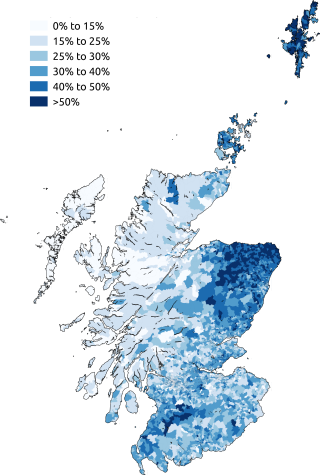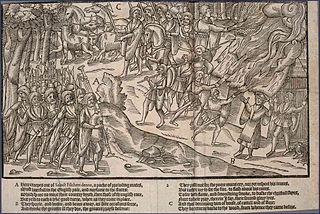Related Research Articles

A dictionary is a listing of lexemes from the lexicon of one or more specific languages, often arranged alphabetically, which may include information on definitions, usage, etymologies, pronunciations, translation, etc. It is a lexicographical reference that shows inter-relationships among the data.
Faroese is a North Germanic language spoken as a first language by about 72,000 Faroe Islanders, around 53,000 of whom reside on the Faroe Islands and 23,000 in other areas, mainly Denmark.

The Oxford English Dictionary (OED) is the principal historical dictionary of the English language, published by Oxford University Press (OUP). It traces the historical development of the English language, providing a comprehensive resource to scholars and academic researchers, as well as describing usage in its many variations throughout the world.
Old English, or Anglo-Saxon, is the earliest recorded form of the English language, spoken in England and southern and eastern Scotland in the early Middle Ages. It was brought to Great Britain by Anglo-Saxon settlers in the mid-5th century, and the first Old English literary works date from the mid-7th century. After the Norman conquest of 1066, English was replaced, for a time, by Anglo-Norman as the language of the upper classes. This is regarded as marking the end of the Old English era, since during this period the English language was heavily influenced by Anglo-Norman, developing into a phase known now as Middle English in England and Early Scots in Scotland.

Scots is an Anglic language variety in the West Germanic language family, spoken in Scotland and parts of Ulster in the north of Ireland. Most commonly spoken in the Scottish Lowlands, Northern Isles and northern Ulster, it is sometimes called Lowland Scots or Broad Scots to distinguish it from Scottish Gaelic, the Goidelic Celtic language that was historically restricted to most of the Scottish Highlands, the Hebrides and Galloway after the 16th century. Modern Scots is a sister language of Modern English, as the two diverged independently from the same source: Early Middle English (1150–1300).

Fianna were small warrior-hunter bands in Gaelic Ireland during the Iron Age and early Middle Ages. A fian was made up of freeborn young males, often aristocrats, "who had left fosterage but had not yet inherited the property needed to settle down as full landowning members of the túath". For most of the year they lived in the wild, hunting, raiding other communities and lands, training, and fighting as mercenaries. Scholars believe the fian was a rite of passage into manhood, and have linked fianna with similar young warrior bands in other early European cultures

A vernacular or vernacular language is in contrast with a "standard language". It refers to the language or dialect that is spoken by people that are inhabiting a particular country or region. The vernacular is typically the native language, normally spoken informally rather than written, and seen as of lower status than more codified forms. It may vary from more prestigious speech varieties in different ways, in that the vernacular can be a distinct stylistic register, a regional dialect, a sociolect, or an independent language. Vernacular is a term for a type of speech variety, generally used to refer to a local language or dialect, as distinct from what is seen as a standard language. The vernacular is contrasted with higher-prestige forms of language, such as national, literary, liturgical or scientific idiom, or a lingua franca, used to facilitate communication across a large area.

The Deutsches Wörterbuch, abbreviated DWB, is the largest and most comprehensive dictionary of the German language in existence. Encompassing modern High German vocabulary in use since 1450, it also includes loanwords adopted from other languages into German. Entries cover the etymology, meanings, attested forms, synonyms, usage peculiarities, and regional differences of words found throughout the German speaking world. The dictionary's historical linguistics approach, illuminated by examples from primary source documents, makes it to German what the Oxford English Dictionary is to English. The first completed DWB lists over 330,000 headwords in 67,000 print columns spanning 32 volumes.

The Annals of the Kingdom of Ireland or the Annals of the Four Masters are chronicles of medieval Irish history. The entries span from the Deluge, dated as 2,242 years after creation to AD 1616.
Feradach Finnfechtnach, son of Crimthann Nia Náir, was, according to medieval Irish legend and historical tradition, a High King of Ireland. There is some disagreement in the sources over his position in the traditional sequence of High Kings.

Crimthann Mór, son of Fidach, also written Crimthand Mór, was a semi-mythological king of Munster and High King of Ireland of the 4th century. He gained territory in Britain and Gaul, but died poisoned by his sister Mongfind. It is possible that he was also recognized as king of Scotland. This Crimthann is to be distinguished from two previous High Kings of Ireland of the same name, two Kings of Leinster, and another King of Munster, among others. Importantly, he is included in the Baile Chuinn Chétchathaig (summary), and is thus the last High King of Ireland from Munster until Brian Bóruma, over six hundred years later.

A kern was a Gaelic warrior, specifically a light infantryman, in Ireland in the late Middle Ages.

The Oxford Latin Dictionary is the standard English lexicon of Classical Latin, compiled from sources written before AD 200. Begun in 1933, it was published in fascicles between 1968 and 1982; a lightly revised second edition was released in 2012.

The Dictionary of Old English (DOE) is a dictionary of the Old English language, published by the Centre for Medieval Studies, University of Toronto, under the direction of Angus Cameron, Ashley Crandell Amos, Antonette diPaolo Healey, and Haruko Momma. It complements the Oxford English Dictionary's comprehensive survey of modern English, the Middle English Dictionary's comprehensive survey of Middle English, and the Scottish Language Dictionaries surveys of Scots.

Early Modern Irish represented a transition between Middle Irish and Modern Irish. Its literary form, Classical Gaelic, was used in Ireland and Scotland from the 13th to the 18th century.

Irish, also known as Gaelic, is a Goidelic language of the Insular Celtic branch of the Celtic language family, which is a part of the Indo-European language family. Irish is indigenous to the island of Ireland and was the population's first language until the 19th century, when English gradually became dominant, particularly in the last decades of the century. Irish is still spoken as a first language in a small number of areas of certain counties such as Cork, Donegal, Galway, and Kerry, as well as smaller areas of counties Mayo, Meath, and Waterford. It is also spoken by a larger group of habitual but non-traditional speakers, mostly in urban areas where the majority are second-language speakers. Daily users in Ireland outside the education system number around 73,000 (1.5%), and the total number of persons who claimed they could speak Irish in April 2016 was 1,761,420, representing 39.8% of respondents.
The Dáirine, later known dynastically as the Corcu Loígde and associated, were the proto-historical rulers of Munster before the rise of the Eóganachta in the 7th century AD. They were derived from or closely associated with the Darini of Ptolemy and were also related to the Ulaid and Dál Riata of Ulster and Scotland. Their ancestors appear frequently in the Ulster Cycle. In historical times the Dáirine were represented, as stated, by the Corcu Loígde, the Uí Fidgenti and Uí Liatháin, as well as a few other early historical kindreds of both Munster and Ulster. In ancient genealogical schemes, the historical Dál Fiatach of Ulaid also belong to the Dáirine.
Lexicography evolved in order to serve one of two needs i.e. in order to explain in a simple way difficult words and expressions or in order to explain the words and expressions of one language in another. In this case we can trace the tradition of lexicography in Irish back to the 8th century.
A historical dictionary or dictionary on historical principles is a dictionary which deals not only with the latterday meanings of words but also the historical development of their forms and meanings. It may also describe the vocabulary of an earlier stage of a language's development without covering present-day usage at all. A historical dictionary is primarily of interest to scholars of language, but may also be used as a general dictionary.
Kathleen "Kate" Mulchrone was an Irish Celtic scholar.
References
- ↑ "eDIL Irish Language Dictionary". Royal Irish Academy.
- ↑ Digitisation of the dictionary of the Irish language (eDIL) Archived January 2, 2015, at the Wayback Machine
- ↑ University of Ulster, eDIL: Progress (Updated 27 April 2006) [ permanent dead link ]